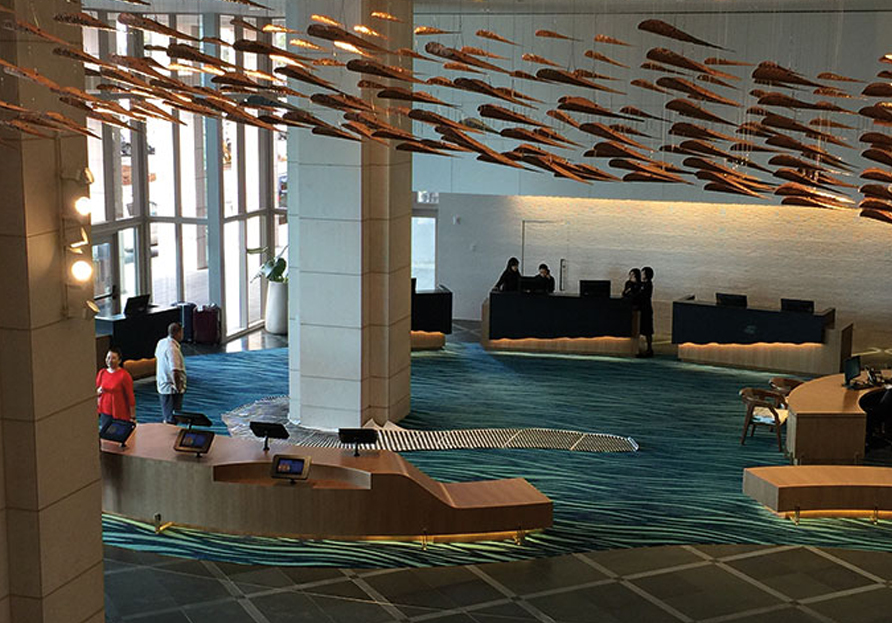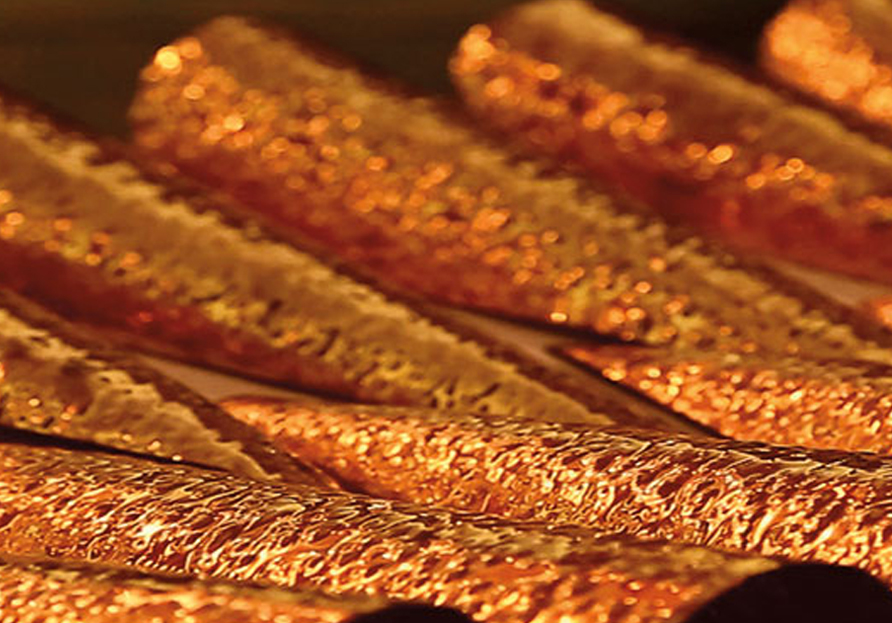Indigenous cultures and the cultures of tourism don’t typically harmonize with each other they seem to have different DNA. And when mixed together, like salt water mixing with fresh, the energy of the place tends to become culturally brackish. But when the art—important art—mixes with a tourist district effectively, hopefully a bit of cultural literacy follows in its wake.
Waikiki is one of those worldwide tourist destinations where the millions of visitors who pass through each year tend to overlook its host culture’s more delicate nuances. Those who never venture beyond the Ala Wai canal, for example, might not know how much more there is to Hawaiians than the stuff depicted on an ABC Store’s shelf of souvenirs. But in the lobby of the Hawaii Prince Hotel Waikiki, as part of its $55.4 million renovation, visitors can get a panoramic sense of place, and all they have to do is look up.
Throughout the lobby, flowing from the mountains of O‘ahu to the ocean, rows and rows of pointed copper pieces hang from the ceiling (850 in all), hammered by hand so that they glisten in the light with multi layered symbolism and meaning. It’s a new installation by O‘ahu-based artist Kaili Chun, called Hulali i ka la, which loosely translates from Hawaiian to “glistening, or shimmering in the sun.”
Chun, who was born in 1962, frequently negotiates space with her work, and the presence of surrounding communities always seems to find its way into her work (Chun is currently pursuing a doctorate at the University of Hawai‘i School of Architecture). In 2006, at the Honolulu Museum of Art (back when it was called the Academy of Arts), Chun employed more than 40 stones to depict Hawaiian mythology, inserting tiny images inside what she called “prophecy stones” and asking the viewer to peer into each. And for 24 hours in 2012, visitors to Waimanalo beach found 50 8-foot steel structures sticking out of the sand and in the surf titled, Veritas II—that moved along the beach as the tide did what it wanted with them. “Organic elements are sometimes included in her pieces,” a gallery presentation for Veritas II explained at the time, “and the changes they undergo during the course of an exhibition metaphorically reference the nature of culture as an evolutionary process.”

While her latest installation is vast, it still sneaks up on you, and you might only think of it as a beautiful piece of architectural design, which it is. But Hulali i ka la is so much more than that because its strongest symbol, while invisible to the uninformed viewer, lies in the creation of the work itself. But to understand it, you’ll need to first learn some history and geography. Before hotels were built on this stretch of Waikiki, there was a hospital, and before that, Chun says, “It was this wiliwai where the wai meets the kai.”
When freshwater comes down the canal and mixes with the bay, it creates undulations in the sand and the water itself. You can see this phenomenon today in Waimea Bay. Indigenous fish called gobies love to spawn in these areas and during their spawning season can be so numerous that you could fish for them by grabbing them from the water by hand. Chun explains that because of all this activity, the area where the Hawaii Prince Hotel Waikiki now stands was once a gathering place for Hawaiians. “Before there was the Ala Wai, before the yacht harbor, it was this place and it was really bountiful,” she says.
So the project’s goal was to find a way to somehow symbolize all of this in one piece: its natural history, as well as its place in Hawaiian culture. Ma Ry Kim, a principal designer for G70, the firm overseeing the hotel’s renovation, says the team was experiencing some creator’s block when it came to this project’s finishing touch.
“For this site in particular it was very important that we honored the story of the site,” Kim says. “But we also wanted to merge art and architecture. With everything we do as designers, bringing beauty to a place is always important … What we’re doing is resurrecting an ancient stream on the ceiling. I could see the whole piece in my head, but it was missing that last critical thing,” she says: the fish.
Each copper pendant is shaped like the belly of a hinana, or goby, and each is hammered to represent the dappling effect of the sun on the sand and water that comes when freshwater and saltwater mix. To have the copper represent fish was Chun’s idea, but even Chun couldn’t foresee how the piece would find its true meaning until it took on a life of its own.
More than 400 people, from hotel staff, friends and family, to longtime clients, pitched into help produce this piece, each volunteered their time to hit hammer against copper. Each piece is marked by its maker in their own way, numbered on a grid so that they can come in and locate it later, and accompanied by a card with information on Hawaiian culture: stuff such as the moon phase of the particular day that they hammered, and whether or not that moon phase was better for fishing or growing kalo.
Because so many volunteers came through, “essentially what this piece became was a people’s project that went beyond anybody’s expectations,” Chun says. “It took a lot of hands to make this; it became a gathering place in its creation.”
It became “their piece and they were able to claim ownership over it,” Chun says. “Which was so meaningful, because instead of an artist coming in and going, ‘OK, here’s the art,’ they were an integral part of Hulali i ka la. It made it so much more meaningful and so much more important to me.”
With great help from long time assistant Nicholas Bright, who streamlined the volunteers and educated them to the process—”This piece couldn’t have been done without him,” Chun says—the piece became “a vessel; the copper was actually a vessel for [the volunteers] to learn about the land and the special place. Now they all know the story, and they know it in a more intimate way than they could have had; I just come in and do a Powerpoint presentation. They literally had a hand in it, and within that small moment of time, they came to understand the story.”
Hopefully, Chun’s piece will also help visitors know the place better—help them become more visually literate to the foundational culture of Hawai‘i and its people—and in doing so, set an example for other hotels to follow.
“I walk into the hotel now and say ‘Ehhh, Hi Robert! Hey, Violet!’” Chun says. “It’s like I’m part of their family now, and they’re a part of mine. To get their involvement in it brought true, real people into a Waikiki hotel art piece.”
Most recently, Chun fills an entire exhibition space for The Honolulu Museum of Art’s (HoMA) seminalArtists of Hawai‘i exhibition, which this year asked artists to create a work that uses spatial experience and viewer participation (Chun is one of four artists featured). Titled Net_work, Chun and collaborator Hongtao Zhou threaded a net-like structure wall to wall throughout a room to create a maze-like experience that a viewer—or in this case, walker—is forced to navigate. The exhibition is on view through May 28, 2017.
